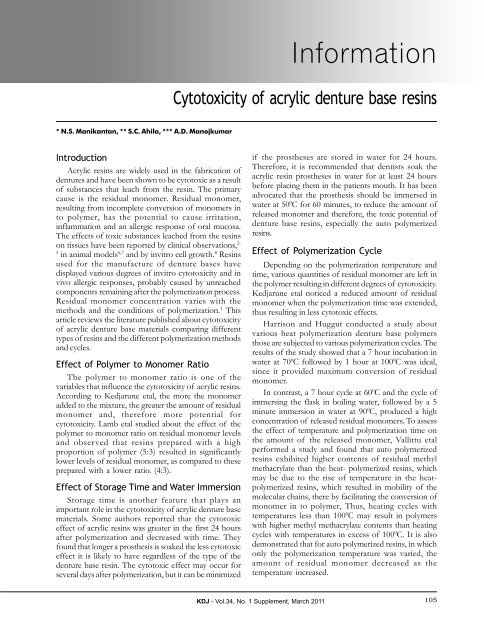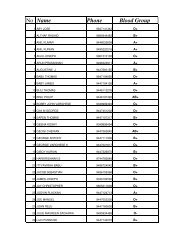Vol 34 No 2 suppli final.pmd - IDA KERALA STATE ::. idakerala.com
Vol 34 No 2 suppli final.pmd - IDA KERALA STATE ::. idakerala.com
Vol 34 No 2 suppli final.pmd - IDA KERALA STATE ::. idakerala.com
Create successful ePaper yourself
Turn your PDF publications into a flip-book with our unique Google optimized e-Paper software.
* N.S. Manikantan, ** S.C. Ahila, *** A.D. Manojkumar<br />
Introduction<br />
Acrylic resins are widely used in the fabrication of<br />
dentures and have been shown to be cytotoxic as a result<br />
of substances that leach from the resin. The primary<br />
cause is the residual monomer. Residual monomer,<br />
resulting from in<strong>com</strong>plete conversion of monomers in<br />
to polymer, has the potential to cause irritation,<br />
inflammation and an allergic response of oral mucosa.<br />
The effects of toxic substances leached from the resins<br />
on tissues have been reported by clinical observations, 2-<br />
5 in animal models 6,7 and by invitro cell growth. 8 Resins<br />
used for the manufacture of denture bases have<br />
displayed various degrees of invitro cytotoxicity and in<br />
vivo allergic responses, probably caused by unreached<br />
<strong>com</strong>ponents remaining after the polymerization process.<br />
Residual monomer concentration varies with the<br />
methods and the conditions of polymerization. 1 This<br />
article reviews the literature published about cytotoxicity<br />
of acrylic denture base materials <strong>com</strong>paring different<br />
types of resins and the different polymerization methods<br />
and cycles.<br />
Effect of Polymer to Monomer Ratio<br />
The polymer to monomer ratio is one of the<br />
variables that influence the cytotoxicity of acrylic resins.<br />
According to Kedjarune etal, the more the monomer<br />
added to the mixture, the greater the amount of residual<br />
monomer and, therefore more potential for<br />
cytotoxicity. Lamb etal studied about the effect of the<br />
polymer to monomer ratio on residual monomer levels<br />
and observed that resins prepared with a high<br />
proportion of polymer (5:3) resulted in significantly<br />
lower levels of residual monomer, as <strong>com</strong>pared to these<br />
prepared with a lower ratio. (4:3).<br />
Effect of Storage Time and Water Immersion<br />
Storage time is another feature that plays an<br />
important role in the cytotoxicity of acrylic denture base<br />
materials. Some authors reported that the cytotoxic<br />
effect of acrylic resins was greater in the first 24 hours<br />
after polymerization and decreased with time. They<br />
found that longer a prosthesis is soaked the less cytotoxic<br />
effect it is likely to have regardless of the type of the<br />
denture base resin. The cytotoxic effect may occur for<br />
several days after polymerization, but it can be minimized<br />
Cytotoxicity of acrylic denture base resins<br />
if the prostheses are stored in water for 24 hours.<br />
Therefore, it is re<strong>com</strong>mended that dentists soak the<br />
acrylic resin prostheses in water for at least 24 hours<br />
before placing them in the patients mouth. It has been<br />
advocated that the prosthesis should be immersed in<br />
water at 50 0 C for 60 minutes, to reduce the amount of<br />
released monomer and therefore, the toxic potential of<br />
denture base resins, especially the auto polymerized<br />
resins.<br />
Effect of Polymerization Cycle<br />
Depending on the polymerization temperature and<br />
time, various quantities of residual monomer are left in<br />
the polymer resulting in different degrees of cytotoxicity.<br />
Kedjarune etal noticed a reduced amount of residual<br />
monomer when the polymerization time was extended,<br />
thus resulting in less cytotoxic effects.<br />
Harrison and Huggut conducted a study about<br />
various heat polymerization denture base polymers<br />
those are subjected to various polymerization cycles. The<br />
results of the study showed that a 7 hour incubation in<br />
water at 70 0 C followed by 1 hour at 100 0 C was ideal,<br />
since it provided maximum conversion of residual<br />
monomer.<br />
In contrast, a 7 hour cycle at 60 0 C and the cycle of<br />
immersing the flask in boiling water, followed by a 5<br />
minute immersion in water at 90 0 C, produced a high<br />
concentration of released residual monomers. To assess<br />
the effect of temperature and polymerization time on<br />
the amount of the released monomer, Vallittu etal<br />
performed a study and found that auto polymerized<br />
resins exhibited higher contents of residual methyl<br />
methacrylate than the heat- polymerized resins, which<br />
may be due to the rise of temperature in the heatpolymerized<br />
resins, which resulted in mobility of the<br />
molecular chains, there by facilitating the conversion of<br />
monomer in to polymer, Thus, heating cycles with<br />
temperatures less than 100 0 C may result in polymers<br />
with higher methyl methacrylate contents than heating<br />
cycles with temperatures in excess of 100 0 C. It is also<br />
demonstrated that for auto polymerized resins, in which<br />
only the polymerization temperature was varied, the<br />
amount of residual monomer decreased as the<br />
temperature increased.<br />
KDJ - <strong>Vol</strong>.<strong>34</strong>, <strong>No</strong>. 1 Supplement, March 2011<br />
Information<br />
105




